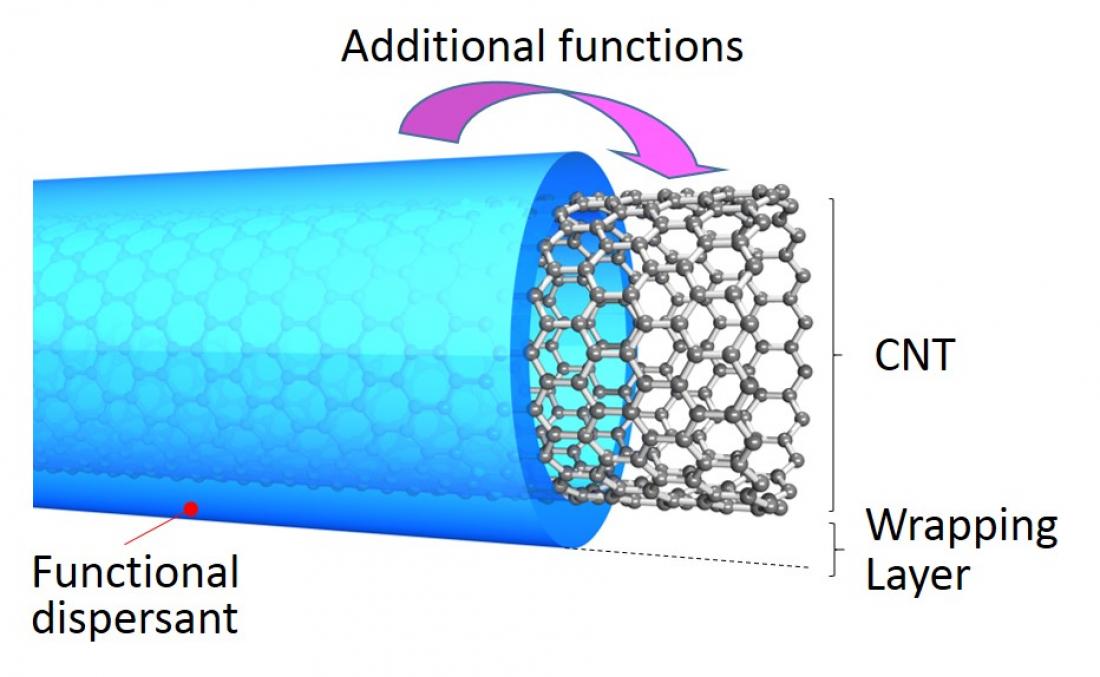Carbon nanotubes wrapped in polymer dispersants are used in many fields, including biotechnology and energy
Scientists first reported carbon nanotubes in the early 1990s. Since then, these tiny cylinders have been part of the quest to reduce the size of technological devices and their components. Carbon nanotubes (CNTs) have very desirable properties. They are 100 times stronger than steel and one-sixth its weight. They have several times the electrical and thermal conductivity of copper. And they have almost none of the environmental or physical degradation issues common to most metals, such as thermal contraction and expansion or erosion.
CNTs have a tendency to aggregate, forming “clumps” of tubes. To utilize their outstanding properties in applications, they need to be dispersed. But they are insoluble in many liquids, making their even dispersion difficult.
Scientists at Japan’s Kyushu University developed a technique that “exfoliates” aggregated clumps of CNTs and disperses them in solvents. It involves wrapping the tubes in a polymer using a bond that does not involve the sharing of electrons. The technique is called non-covalent polymer wrapping. Whereas sharing electrons through covalent polymer wrapping leads to a more stable bond, it also changes the intrinsic desirable properties of the carbon nanotubes. Non-covalent wrapping is thus considered superior in most cases because it causes minimum damage to the tubes.
The scientists, Dr. Tsuyohiko Fujigaya and Dr. Naotoshi Nakashima, conducted a research review to analyze the various approaches of polymer wrapping and to summarize the applications in which polymer-wrapped carbon nanotubes can be used. Their review has been published in Science and Technology of Advanced Materials (16-2 p24802, 2015).
They found that a wide variety of polymers can be used for the non-covalent wrapping of carbon nanotubes. Recently, many polymer dispersants have indeed been developed that not only disperse the CNTs but also add new functions to them. These polymer dispersants are now widely recognized and utilized in many fields, including biotechnology and energy applications.
CNTs that are stably wrapped with biocompatible materials are very attractive in biomedicine, for example, due to their incredible ability to pass biological barriers without generating an immune response. There is thus high potential for polymer-wrapped CNTs in the area of drug delivery.
Also, wrapping carbon nanotubes in polymers improves their photovoltaic functions in solar cells, for example, when the polymers function like a light-receiving pigment.
Because the designs of polymers can be readily tailored, it is expected that the functionality of polymer-wrapped CNTs will be further expanded and that novel applications using them will be developed.
For more information, contact
Tsuyohiko Fujigaya
The World Premier International Research Center Initiative
International Institute for Carbon-Neutral Energy Research (WPI-I2CNER)
Kyushu University
E-mail: [email protected]
More information about the research paper:
Sci. Technol. Adv. Mater. Vol. 16 (2015) 024802
http://iopscience.iop.org/1468-6996/16/2/024802/article
doi:10.1088/1468-6996/16/2/ 024802
Non-covalent polymer wrapping of carbon nanotubes and the role of wrapped polymers as functional dispersants
Tsuyohiko Fujigaya and Naotoshi Nakashima
Journal Information
Science and Technology of Advanced Materials (STAM) is the leading open access, international journal for outstanding research articles across all aspects of materials science. Our audience is the international materials community across the disciplines of materials science, physics, chemistry, biology as well as engineering.
The journal covers a broad spectrum of materials science research including functional materials, synthesis and processing, theoretical analyses, characterization and properties of materials. Emphasis is placed on the interdisciplinary nature of materials science and issues at the forefront of the field, such as energy and environmental issues, as well as medical and bioengineering applications
http://iopscience.iop.org/1468-6996
For more information about the journal Science and Technology of Advanced Materials, contact
Mikiko Tanifuji
Publishing Director
Science and Technology of Advanced Materials
Email: [email protected]



